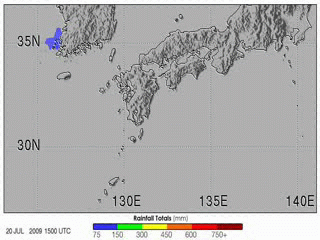Vaizdas:Heavy Rains in Southern Japan.gif
Heavy_Rains_in_Southern_Japan.gif (320 × 240 taškų, rinkmenos dydis: 8,35 MiB, MIME tipas: image/gif, ciklinis, 268 kadrai, 8,0 s)
Rinkmenos istorija
Paspauskite ant datos/laiko, kad pamatytumėte rinkmeną tokią, kokia ji buvo tuo metu.
| Data/Laikas | Miniatiūra | Matmenys | Naudotojas | Paaiškinimas | |
|---|---|---|---|---|---|
| dabartinis | 00:56, 1 rugpjūčio 2009 |  | 320 × 240 (8,35 MiB) | Originalwana | {{Information |Description={{en|1=The 2009 summer monsoon brought torrential rains to south western Japan in July. This animatin shows rainfall estimates for southern Japan and the surrounding region from July 20–27. The most prominent feature is a larg |
Paveikslėlio naudojimas
Paveikslėlis nenaudojamas nei viename straipsnyje.
Visuotinis rinkmenos naudojimas
Ši rinkmena naudojama šiose viki svetainėse:
- Naudojama cs.wikipedia.org
- Naudojama en.wikipedia.org
- Naudojama fi.wikipedia.org
- Naudojama id.wikipedia.org
- Naudojama ja.wikipedia.org
- Naudojama ms.wikipedia.org
- Naudojama si.wikipedia.org
- Naudojama te.wikipedia.org
- Naudojama uk.wikipedia.org
- Naudojama vi.wikipedia.org
- Naudojama www.wikidata.org
- Naudojama zh.wikipedia.org




